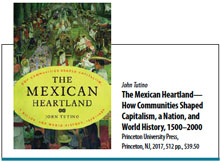Book Reviews
Mexico’s Lesson in Capitalism
John Tutino
The Mexican Heartland: How Communities Shaped Capitalism, a Nation, and World History, 1500–2000
Princeton University Press, Princeton, NJ, 2017, 512 pp., $39.50

In this formidable work of scholarship, Georgetown University historian John Tutino recounts Mexico’s long journey to modernity from the standpoint of small communities surrounding Mexico City. This ambitious exercise spans five centuries to analyze how these communities “built, sustained, subsidized, resisted and changed capitalism” in its various phases from silver-based imperial capitalism under Spanish rule to the shift from national capitalism to liberal globalism in the late 20th century.
Tutino gives a rich description of the clash between traditional community life and the expansion of capitalism through the centuries and tells the stories of people in communities such as Chalco, Tenango del Valle, and Tepoztlán, places exhibiting the enduring traits of the Mexican heartland: poverty, productive communitarianism, local autonomy, and patriarchalism.
A key theme of the book is the resilience that allowed communities to retain, with varying success, a degree of the ecological, political, and cultural autonomies secured during the era of the global silver economy under Spanish rule. In the late 19th century liberal capitalism brought with it a concentration of land ownership that, combined with population growth and mechanization, undermined the patriarchal family system. Tutino describes how this led to rising violence, both within families and by armed rebellion. The ultimate result was land reform yielding a temporary renewal of autonomy. But strong population growth in the 20th century and the rapid expansion of Mexico City sapped the rural heartland and left most of its people struggling to build satisfactory lives in the sprawling conurbation.
For Tutino, this phase, and the subsequent collapse of national capitalism with the “triumph of globalization” since the 1980s, marked the definitive end of local autonomies. Yet the author may have marked the ending too early. The clash between traditional communities and liberal capitalism was still evident in 2006 when riots led by the community of San Salvador Atenco forced the new Mexico City airport project to be postponed for 10 years.
The author also seems to suggest that capitalism’s incompatibility with traditional autonomous communitarianism implies a choice between social erosion and inclusion. Yet some of the most open and market-oriented economies are also among those with the best track records on inclusiveness and the environment.
While Tutino may be right to say that it remains to be seen “how people will make communities and press their needs in our new world,” there is as much reason to be optimistic about this as pessimistic. Openness of the economy and social inclusion do not, of course, come about automatically. The right policies are needed for the sort of inclusive and sustainable growth that can combat poverty while safeguarding the environment and fostering human rights and democracy. At a 2017 meeting of the Organisation for Economic Co-operation and Development, which I lead, the Network of Open Economies and Inclusive Societies was established to champion this combination. The OECD has been working closely with the Mexican authorities to design and implement reforms that simultaneously boost productivity and improve the inclusiveness of growth. I hope and believe that, for the Mexican heartland, the best is yet to come.
Opinions expressed in articles and other materials are those of the authors; they do not necessarily reflect IMF policy.








